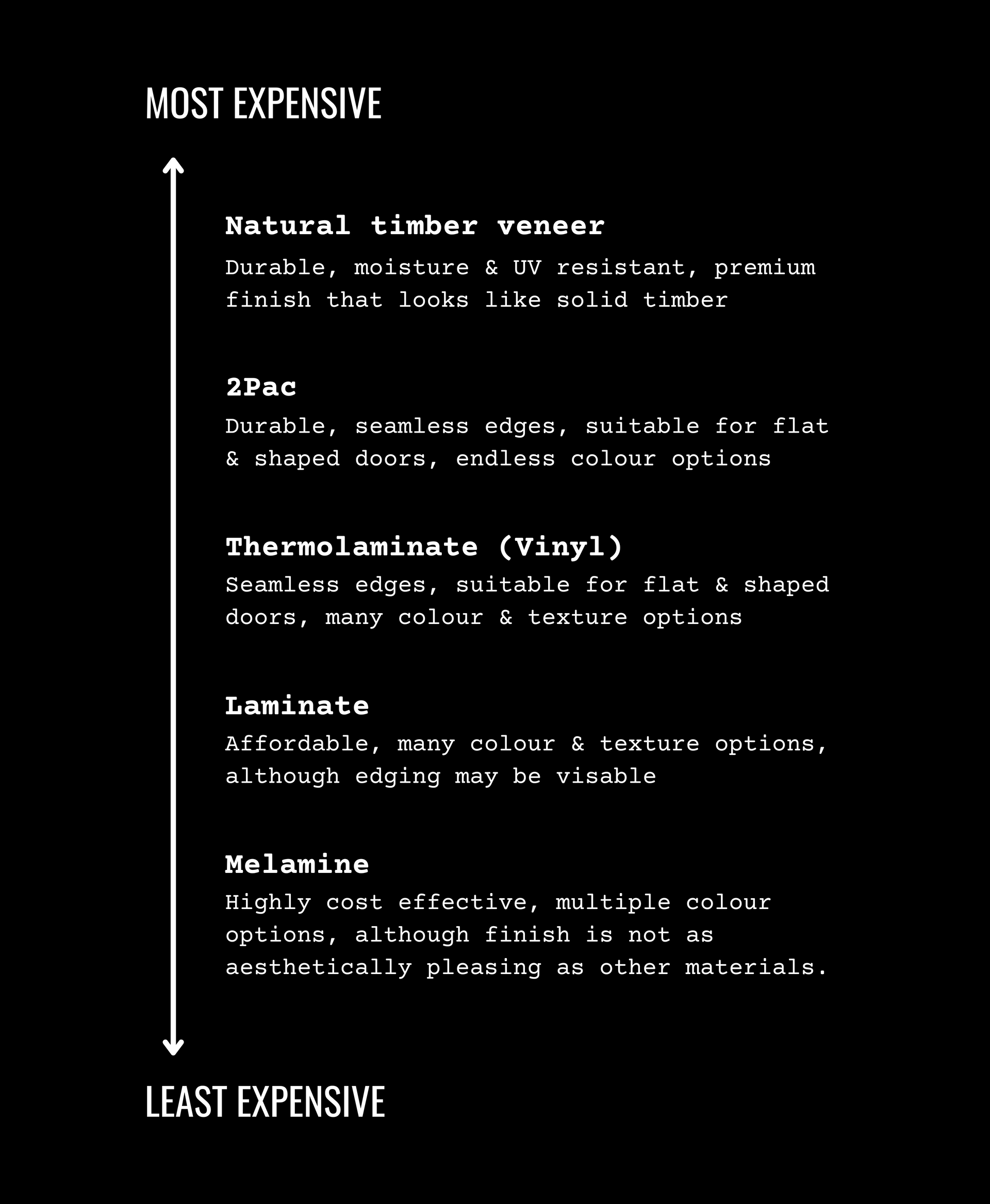materials & finishes
materials & finishes
CABINET MATERIALS
There are many different types of materials on the market with different qualities and application purposes.
-
Melamine
Cabinet interiors or carcasses are typically made from 16mm HMR (High Moisture Resistant) white melamine, backed by a particle board substrate. Melamine is also available in a wide range of colors and finishes, with either particle board or MDF substrate options, and can be utilized for doors and panels.
Advantages
- Highly cost-effective
- Easy to work with
- Comes in a variety of colors and finishes
- Requires minimal maintenance
- Offers a certain level of durability
- Both the front and back of the door exhibit the same color
Disadvantages
- The texture of the melamine may not be aesthetically pleasing to some
- Requires matching ABS edging on exposed edges, which can be noticeable if not properly applied
- Limited to flat doors, as it cannot facilitate any door profile.
-
Laminate
Laminate doors are a popular choice due to their cost-effectiveness, enhanced durability compared to melamine, and the variety of colours and finishes available.
Advantages
- Highly cost-effective, second only to melamine
- Comes in various colors and finishes
- Requires minimal maintenance
- Exhibits greater durability than melamine
Disadvantages
- Can be slightly more challenging to work with
- Most laminate options come with only one high-quality face. For instance, if you choose a super matt black laminate door, the back of the door will also be black, but without the super matt finish. Suppliers can offer the same finish on both sides, but this typically requires a special order and can be quite expensive.
- Similar to melamine, laminate also needs matching ABS edging on exposed edges, which can be noticeable if not correctly applied.
- It is more expensive than melamine.
-
Thermolaminate (Vinyl)
Thermolaminate doors are created by vacuum-forming a film onto an MDF substrate. They are available in various colors, textures, and profiles. A significant advantage of thermolaminate is its seamless look and feel, achieved as the film wraps around the face of the doors and all exposed edges.
Advantages
- Wide array of colours and textures to choose from
- Various profile options, such as shaker style, cove, etc.
- Seamless edges for a clean and smooth appearance
Disadvantages
- Less cost-effective compared to melamine and laminate
- Requires careful maintenance, or the film may start to peel
- The back of the door typically comes in either white or black depending on the colour of the vinyl
-
2Pac
2Pac paint is a coating system that involves the reaction of hydroxyl groups (part A) with isocyanate resin (part B). This reaction results in a painted surface coating renowned for its superior durability and resistance, particularly against heat and moisture.
It's recognised as a premium finish for kitchens, wardrobes, and other cabinetry due to its durability and the freedom it offers to choose from virtually any paint colour from major suppliers like DULUX, PORTERS, TAUBMANS, etc.
You also have the option to select the finish in matt (10%), satin (30%), semi-gloss (60%), and high gloss (100%). 2Pac finish allows you to match any colour; for instance, if you have existing cabinetry with a 2Pac finish and want your new cabinetry to match that colour, we can arrange a colour match.
Advantages
- High durability
- Profile options such as shaker style, cove, etc.
- Seamless edge for a clean look
- Ability to choose any desired colour
- Variety of gloss level finishes
Disadvantages
- More expensive than other options
- Prone to showing fingerprints
- Susceptible to chipping
-
Natural timber veneer
Natural timber veneer is a thin layer of real wood that's adhered to a less expensive material, often particleboard or MDF, providing the look and feel of solid wood.
This material comes in various types, each offering unique grain patterns and colours, allowing for a range of aesthetic options. Natural timber veneer is appreciated for its warm, organic appeal that can add a touch of nature to your kitchen, wardrobe, and other cabinetry.
Advantages
- Provides the authentic appearance and texture of solid wood
- Available in a wide array of wood types, colours, and grain patterns
- Adds a warm, natural aesthetic to rooms
Disadvantages
- More expensive option
- Requires careful maintenance to preserve its appearance
- Colour and pattern might vary due to the natural variation in wood grains

BENCHTOP MATERIALS
Benchtops come in a variety of materials, each offering unique benefits and drawbacks.
-
Laminate
Laminate benchtops are cost-effective and come in a wide array of colours and patterns. They're relatively easy to maintain but are susceptible to damage from heat and sharp objects.
-
Natural Stones (Marble, Granite)
Natural stone benchtops like marble and granite offer a luxurious aesthetic and excellent durability. However, they require regular sealing to prevent staining and can be on the expensive side.
-
Engineered Stone
Engineered stone benchtops are crafted from a blend of natural quartz particles and resins, creating a durable surface that mimics the luxurious appearance of natural stone.
Known for their strength and versatility, these benchtops offer a wide range of colours and finishes, making them a popular choice for stylish and low-maintenance kitchen and bathroom designs.
-
Solid Surface
Solid surface benchtops are non-porous, making them resistant to stains and bacteria. They can be seamlessly installed for a sleek look but can be prone to scratches and heat damage.
-
Porcelain
Porcelain benchtops are incredibly durable, resistant to scratches, heat, and stains. They also offer a modern aesthetic. However, they can be costly and may chip or crack if heavy objects are dropped on them.
-
Concrete
Concrete benchtops offer an industrial aesthetic and can be customised in terms of colour and finish. They're robust and long-lasting, but they can be porous if not properly sealed and might develop cracks over time.
-
Solid Timber
Solid timber benchtops add a warm, natural aesthetic to your space. They're durable and can be refinished multiple times, but they require regular oiling to prevent drying and cracking and can be damaged by heat and moisture.
SOME OF OUR PREFERRED BENCHTOP SUPPLIERS:
Stone Ambassador
Smart Stone
Victoria Stone Gallery
Caesarstone
YDL Stone
HARDWARE
While there are many different hardware suppliers, we choose the best available to complement our craftmanship, detailed and high quality cabinetry.
Our go-to brands are Blum, Hafele, and Salice, renowned for their superior products in the market.
-
Blum
Our primary choice for door hinges and drawer runners is Blum, known for their high-quality and durable products. Notably, Blum provides a lifetime warranty on some of their products, reflecting their confidence in the longevity and performance of their hardware.
-
Hafele
We utilise Hafele for specific needs such as pull-out bins, pull-out pantries, and laundry hampers. Hafele's products are designed with functionality and ease-of-use in mind, making them an excellent choice for these applications.
-
Salice
Another brand we trust is Salice, which offers a wide range of hardware options that combine innovation, quality, and durability.
SOME OF OUR GO-TO HARDWARE SUPPLIERS:
Blum
Hafele
Salice

